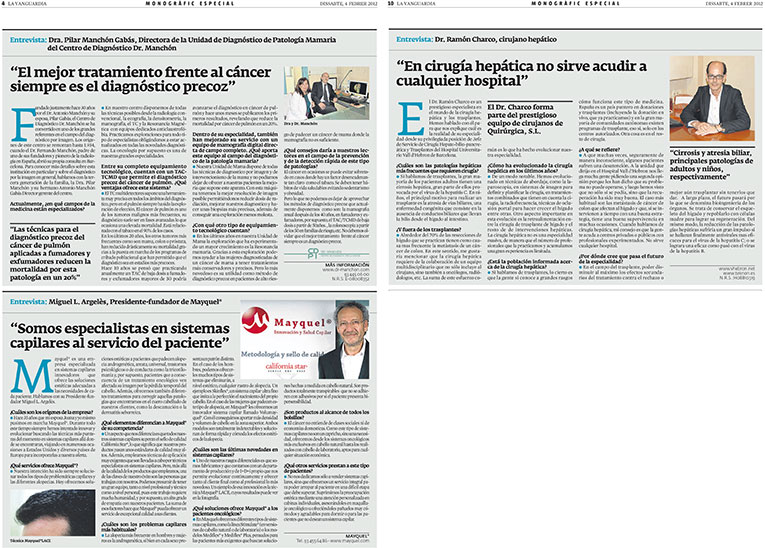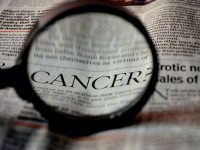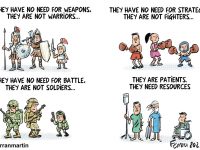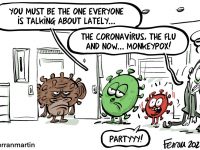Hovering between stigma and trivialisation
World Cancer Day in the Spanish press
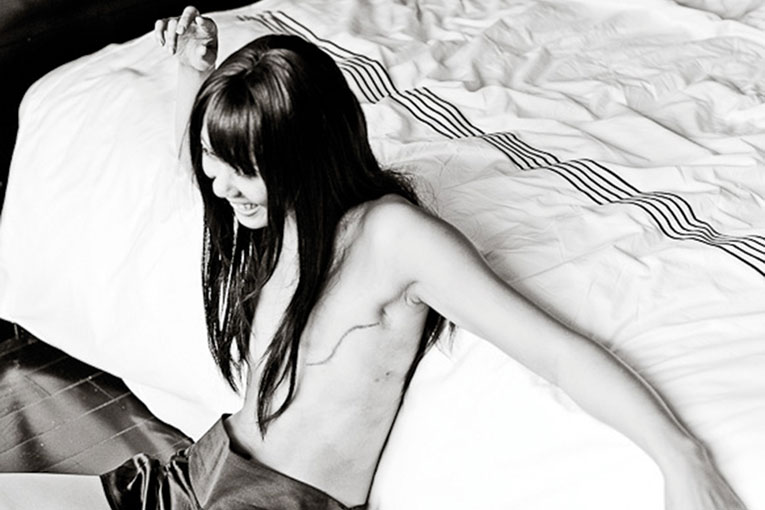
ABSTRACT
Cancer is a prominent topic of public interest. While simultaneously refl ecting and shaping social values, the mass media convey an image of this disease that is not always as careful and informative as it could be. This article analyses the media coverage of World Cancer Day during the last decade, as reported by the four newspapers with the largest readership in Spain. The aim is to analyse how they made use of the event to provide information on cancer, and whether the information was accurate and rigorous or fell into the trap of stereotype and sensationalism.
Keywords: cancer, treatment of information, World Cancer Day, illness, sensationalism.
Information on health issues in the press has experienced a significant increase in recent decades. The dissemination of new technologies and the inclusion of sections devoted to health and science have boosted news related to these topics. In this context, diseases receiving most media coverage – like cancer – represented a secondary topic of interest to the daily press between 1997 and 2006 (Revuelta i De Semir, 2008).
However, apart from this discreet – albeit continued – presence of illness in the media, we should ask ourselves whether the information provided to the public can be considered rigorous and sufficient. This article focuses on a study of how the Spanish press portrayed World Cancer Day, in an endeavour to identify the major trends.
In Spain cancer is reported to be the leading cause of death in men and the second in women since 2005 (Cabanes et al., 2009). Lung cancer is the type causing highest mortality among men, while breast cancer comes top in women. Despite these data, overall survival has improved markedly since the nineties, so it is increasingly common to find groups of people who have survived one type of cancer or another, and who call for a less alarming vision of the disease. Nonetheless, cancer is still too often identified with a kind of death sentence, making it difficult for people with the disease to live a fully integrated life. Why is it so difficult to change this view of cancer? What role does the mass media play in the public perception of this disease?
DIA MUNDIAL DEL CÀNCER
Commemoration of World Cancer Day is of recent origin, dating back to the Charter of Paris (statement of objectives in the fight against cancer in the new millennium) signed on February 4, 2000 by the French President at that time, Jacques Chirac, and the director of UNESCO, Koichiro Matsuura. The last point in the Charter suggested the 4th of February should become World Cancer Day.
Undoubtedly international recognition of a date to commemorate an illness should encourage the mass media to echo it. In the context of influencing public opinion, it is highly advantageous for an event to be highlighted by the mass media, because a direct relationship is established between what the media highlights and what the public considers important (McCombs, 2006).
«The word ‘cancer’ is so loaded with negative connotations that for years patients, doctors, mass media and society at large avoided pronouncing it»
Despite the increase in new media channels, the press continues to be a main reference, both for citizens and for the other media, which often act as sounding boards for what the newspapers publish. Therefore, our analysis of World Cancer Day has focused on the four newspapers with the widest state circulation El País, El Mundo, La Vanguardia and Abc1, The study encompasses the last decade (2002- 2012) and looks at how the disease was reported and whether it was dealt with in an accurate and rigorous way or, conversely, if reporters tended to fall into the traps of stereotype and sensationalism.
We have included information on cancer appearing on the 4th of February, and those that made specific reference to World Cancer Day, published on both the day before and the day after this date.
The first reference found to World Cancer Day in this decade was in 2004, in a news item in El Mundo (5/2/2004). During the following years, news appeared sporadically around the 4th of February. The year 2008 saw an increase in information following the contract signed between the researcher Erwin Wagner and the Spanish National Cancer Research Centre (CNIO), which took advantage of this event to make this scientist known to the public. By 2011 and 2012 it would appear that this date had become consolidated on the press’ agenda, although – as we will see – treatment of the issue experienced a change in some newspapers with a tendency for information to become more market focused.
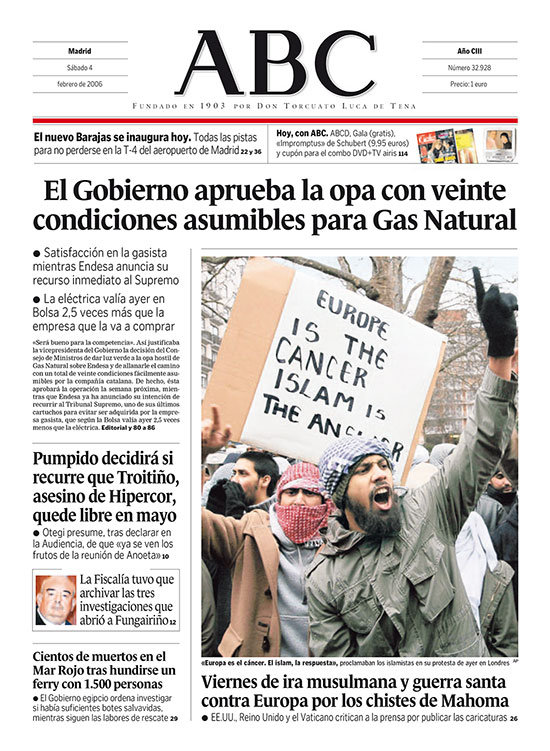
«Europe is the cancer. Islam is the answer». Banner sported by Islam protesters against the Mohammed cartoons published in a Danish newspaper. It is precisely this usage of the word cancer as a synonym of social destruction that medical and patient associations denounce.
METAPHORS AND OTHER TROPES
The word cancer is so loaded with negative connotations that for years patients, doctors, mass media and society at large have avoided pronouncing it (in this respect we often hear euphemisms like «a long illness» to avoid the word in question). Although things have begun to change, this word is still associated with harsh medical treatment, physical decline and even death. This means that cancer is still feared, a strange and isolating concept, an ideal candidate for stigmatisation.
The sociologist Ervin Goffman stated that stigma occurs when a person has «an undesirable difference we had not anticipated» (Goffman, 1993). This difference catches our attention and overshadows all the other attributes so we only see a portion of the person (in this case the disease) as the whole, as his or her overall identity
In the press, as well as in common everyday language, there is another way of approaching cancer: one that uses a clear analogy with war or warlike images. The news items reviewed display several concepts that are part of this semantic field: fight, advance, battle, strategy, main weapons, attack, threat, invade… are all good examples of these military parallels drawn between the disease and its cure.
In her book Illness as Metaphor, the writer Susan Sontag explained that the «militarisation» of serious diseases emerged in the late nineteenth century, with the identification of microorganisms as causative agents of diseases: «bacteria were said to “invade” or “infiltrate” the cells of the body». Sontag, who wrote the book after being diagnosed with cancer, recognised that what bothered her most was to realise how much the reputation of the disease itself increased the suffering of those affected by it, pointing out how military metaphors contributed to stigmatising certain diseases, and therefore all those affected by them.
Consistent with this, we found expressions like: cancer «advances»; breast tumours represent «the worst threat» to the female population (Abc, 3/2/2009), Spanish institutions are involved in «the fight to combat the disease»(El País, 5/2/2008) putting out your cigarette is not enough «to stay out of danger» (Abc, 5/2/2008).
As evident in the information analysed, the language debate surrounding the word cancer endures. In 2011, on occasion of World Cancer Day, several groups requested that the word cancer should not be used as a synonym for destruction, and also that the Royal Spanish Academy of Language (RAE) should eliminate the fourth meaning in its dictionary, stating: «Proliferation of destructive situations or events within a social group. Drugs are the cancer of our society».
The proposal received a rapid but highly critical response from two columnists. The first article stated:
To date the utmost people demanded was to replace one word for another, like blind for sightless. But now they want something more sophisticated: to take a word like one would take a layer of intestine, hollow it out and stuff it with blood and onion; thereby turning cancer into a sausage, free of negativity and destruction, suitable for parlours.
Arcadi Espada, «Amable cáncer». El Mundo, 03/02/2011.
The second, took a similar stand:
It is stupid to aspire through language not just to condition the mind but to change physical reality, one that goes beyond our subjective theatrical representations. Thus we commit the folly of wanting to equate cancer with a cold via a linguistic coup. And this habit spreads, extends like a metastasis, like a cruel carcinoma. Bureaucrats of language, ringleaders who attempt to take over the dictionary, these are the real cancer of language.
Pedro Ugarte, «Cáncer». El País, 05/02/2011.
«In the press, as well as in common everyday language, there is another way of approaching cancer: one that uses a clear analogy with war or warlike images»
Our analysis of the decade shows that information dominated opinion, contributing to provide objectivity and neutrality on the subject. Only four of the items belonged to the opinion genre: the two items mentioned above (El Mundo, 3/2/2011 and El País, 5/2/2011), an editorial on overcoming cancer (La Vanguardia, 4/2/2011) and an article written by specialists in oncology (El País, 4/2/2012). The fact that the only controversial element observed in articles on cancer dealt with the language used to refer to the disease exemplifies the negative connotations that society links to the word cancer. Furthermore, the fact journalists used the word cancer in the same way as that objected to by patients and medical associations in order to criticise the request made («…[they] are the real cancer of language») shows how deeply rooted the association of cancer is with systematic destruction (of a society, of a language…). So much so, that some journalists are openly opposed to abandoning it.
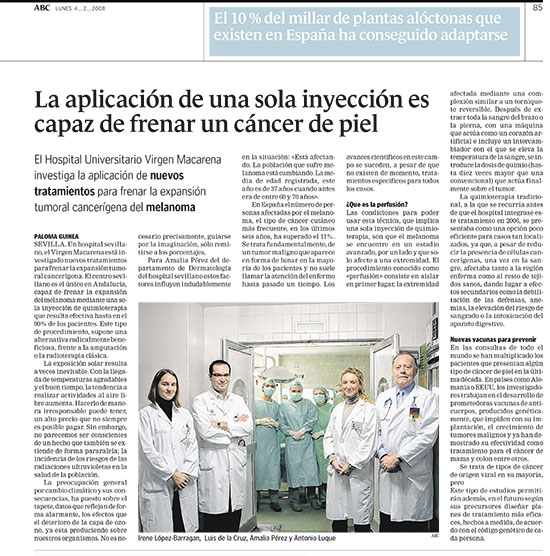
This headline («Administering a Single Injection Can Stop Skin Cancer») resorts to sensationalism by exaggerating a piece of news that is later on clarifi ed and expanded. This contributes to raising false expectations and confuses both patients and the general public.
THE PITFALLS OF SENSATIONALISM
With respect to the news items analysed, many of them provided cancer-related data reported by numerous agencies on the occasion of World Cancer Day. This numerical and statistical information is often tedious to read and so – on transmitting it to the public – the mass media often resorts to sensationalism to make it more attractive. Thus we found some headlines like «Lung Cancer Kills One Person every Half Hour» (El Mundo, 4/2/2005) or «One in Three Spanish People Suffer Cancer once in their Lifetime» (Abc, 3/2/2009). The latter news item also used expressions such as «cancer advances» or «devastating statistics», which help to spread the feeling of being in imminent and alarming danger.
Another sensationalist way of dealing with information was just the opposite, with an overstatement of optimism which must then be qualified within the text, like this headline from ABC: «Administering a Single Injection Can Stop Skin Cancer» (Abc, 4/2/2008). This is what is referred to as «breakthrough syndrome» in some studies (Ransohoff and Ransohoff, 2001). An exaggeration of the benefits of therapies or clinical trials may lead, ultimately, to creating false expectations among less well-informed patients. In other cases shocking headlines out of context could plant the idea in the public’s perception that genetic determinism reigns over other variables: «Giving birth over 39 increases the risk of daughters developing cancer» (Abc, 4/2/2012).
«Cancer continues to be portrayed as the enemy, a battle that must be fought and won, while sensationalism is perpetuated, running the risk of misinforming»
If we check the sources used by most of the news items studied they prove to be reliable (researchers, medical institutions and patients). So what underlies this tendency to resort to sensationalism? It stands to reason that the original information presented is accurate and that the process of distortion occurs later in the drafting of the news report. In this respect, studies such as that by Brechman, Lee and Cappella (2011) indicate that distortion (in the case of the genetic information they investigated) takes place between the press release and news items. They explain that first scientific research results are published in academic journals. These journals have press offices that emit press releases, transmitting the results to the mass media, which eventually publicise the information. Often, there is a big gap between the original article and the news that finally appears in the newspaper. These inaccuracies are attributed to the very nature of journalism: the information must be simplified so it can be understood by a broader audience. However, according to these authors, sometimes it is the press office which issues news in sensationalist tones to ensure better press coverage of the topic. Indeed, it has been found that the general press coverage of scientific studies increases their citation indexing within the scientific community (Phillips et al., 1991), and in some cases this media impact can even influence the leading research areas within cancer studies (Smith et al., 2010). Thus, the relationship between the press and research in cancer is much more closely interwoven and complex than might be supposed at first sight.
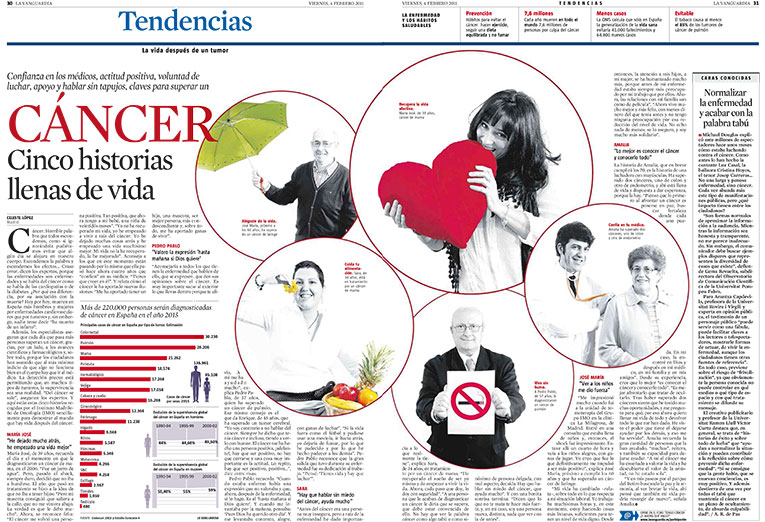
La Vanguardia ’s report published on the occasion of World Cancer Day in 2011 and 2012. The 2011 article was appealing and rigourous, while in 2012 the newspaper chose to publish a special booklet entitled «Investing in Health» where information was mixed with publicity.
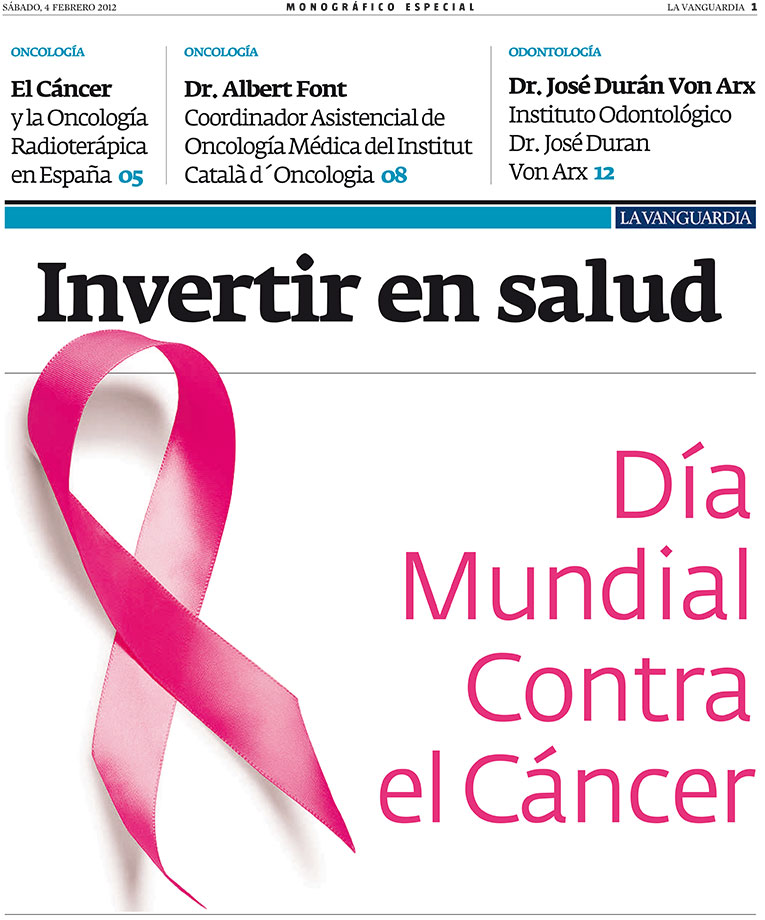
FLIPPANCY AND MARKETING
Another way to ensure coverage in the mass media is by paying for an advertising campaign. Traditionally, there was a clear distinction between advertising and information based on reader’s choice of press: newspaper, magazine, journal, etc. It is only within the current context of an economic recession, which is hitting the printed press particularly hard, can we try to «understand» (not justify) certain changes observed in the news coverage of World Cancer Day.
Thus, the daily newspaper La Vanguardia, which had provided faultless coverage of the event in 2011 (with a report, inviting readers to participate in a forum on the subject on the web and tips about healthy habits), took a turn around in 2012, changing its approach by publishing a questionable blend of information and advertising. On February 4, 2012 almost all the information published in this daily related to World Cancer Day (except one page) was published in a special booklet entitled «Investing in Health». The booklet, with its own masthead (listing those responsible), sported two logos: Publi Press Media, in charge of selling advertising for the media communications company Grupo Godó, and the industrial press group known as Editorial de Prensa Industrial, Grupo HORO. Reference was also made to a webpage (www.guiadeprensa.com) which, in the «press» section states: «Your company has a lot to tell, and Grupo HORO offers you access to large national communications media reaching a huge audience to inform them about your company, and what products and services it provides». In other words, the paper took advantage of the event to publish a strictly commercial booklet.
«Commodification of content also contributes to trivialisation of the disease, creating a more flippant image and turning it into a business target»
The supplement devoted numerous pages to clinics, laboratories and institutes, both public and private, in a hybrid format that did not distinguish between information and advertising. Nowhere did it specify that it was a commercial supplement. The pages included texts describing the features and benefits of the places advertised (number of beds and equipment when referring to clinics, new techniques, etc.). Below the text, one could find the respective contact information (address and telephone number) and, in some cases, the logo of the company in question (La Vanguardia, special supplement, p. 7) or even «improved survival of cancer patients treated by multidisciplinary teams» (p. 9).
So without going into deeper assessment, we find that in this case biased information – often produced by the clinics themselves and unsigned by journalists – is reaching the public disguised as neutral information: informative structure, newsy writing style and included in a prestigious newspaper on the occasion of World Cancer Day
This is the clearest case of commodification of content. Furthermore, we found some more subtle ways of trying to generate profits from this information, as in the case of the newspaper El Mundo, which published a report on February 3, 2012 – to commemorate World Cancer Day – entitled «Ten “forgotten” questions about cancer». It was a selection of ten questions of the twenty-four published by the National Cancer Institute (NCI) on the Internet. At the end of the item, the reader was encouraged to visit Orbyt (the newspaper’s paid-access platform) to read the analytical review by José Luis de la Serna (in-house physician and consultant on health issues published in the newspaper) and consult the NCI project. This was a way of attracting readers to Orbyt, when the full content of the questions raised by the NCI was available on the free-access site Provocative Questions.
A WELL INFORMED SOCIETY?
Thus far, can we say that our society is well informed about the problems of cancer? Obviously, it is maybe too bold to draw decisive conclusions with such a limited corpus of analysis; however, we may pick out certain issues. Overall, considering the news items analysed in this article, there has been scarce information in the newspapers on World Cancer Day for the past decade, especially in the early years, although it did increase in volume over time. This can be attributed to the fact that the event has not been fully consolidated yet and also that the concept of cancer in general does not stir up as much interest as, say, breast cancer, which has come to the forefront of news items.
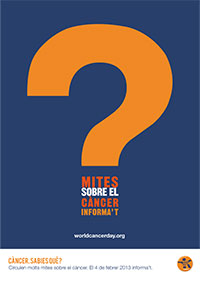
2013 World Cancer Day poster. This year it has emphasised the importance of banishing myths and false ideas about the illness. More information available at www.worldcancerday.org / World Cancer Day 2013
Our analysis also warns of a dual trend in the information analysed. On the one hand, cancer continues to be portrayed as the enemy, a battle that must be fought and won, while on the other, certain sensationalism is perpetuated. The danger of this stance is that it can lead to misinformation, raising false expectations among readers who may then become sceptical and dismiss valid advice like adopting a healthy lifestyle. Furthermore, the commodification of content also contributes to trivialisation of the disease, creating a more flippant image and turning it into a business target. Despite the current economic recession, the value of news cannot be replaced by economic or business interests. Otherwise, the press risks losing its credibility, the very foundation upon which its relationship with the reader is built.
In short, we found the commemoration of World Cancer Day received dissimilar treatment in the newspapers and time span analysed, with the event often leading to sensational headlines in an attempt to make the information more attractive. Another danger that has come to light is the confusing blend between information and advertising that can mislead the reader. Cancer is an issue that seriously affects people’s health and wellbeing and therefore deserves rigorous and contextualised reporting, to provide the public with a degree of realistic and truthful knowledge about the disease. Clearly this is not the sole responsibility of the mass media – far from it – and should involve institutions, researchers, associations and other information agencies involved in this process. However, the mass media in general – and the press in particular – plays a fundamental role in converting information into knowledge that is accessible to the wider public.
1.According to a 2012 survey by the EGM (General Media Study) (Go back)
NORMALISATION, YES; TRIVIALISATION, NO
Talking about cancer in general does not seem that interesting to the press. Rather, attention is focused on certain types of cancer, especially breast cancer, which currently receives most media attention. According to the 2011 report by the Quiral Project, Observatory of Scientifi c Communication, dedicated to analysing news about cancer in the Spanish press that year, breast cancer took the lead – at a great distance from the other tumours – in the information published.
But does this increased presence of information lead to a better understanding? Some voices, mainly in the United States, have begun to criticise what they consider to be a trivialisation and commercialisation of this disease. The documentary Pink Ribbons Inc. by the Canadian Léa Pool (2012), based on Samantha King’s novel of the same title, delves into this issue. During the month of October, when the World Day Against Breast Cancer is celebrated, shopping malls are fl ooded with a tide of pink products and numerous fund-raising activities are held. The documentary, which touches on several issues, not without stirring up controversy, calls on civil society to begin to take an active role in fi nding out where the money really goes: what percentage of sales or profi ts goes to research, which research groups and what type of research is funded.
Criticism is also voiced of the attempt to disguise the disease with a veneer of excessive «normality», encouraging women to stay feminine and attractive during and after treatment. According to numerous groups, cancer patients will be able to lead a normal life when society is able to accept cancer without having to sprinkle it with sugar.
Following this train of thought, when a friend of his became ill, the fashion photographer David Jay began what has come to be known as Projecte SCAR. ay photographs women with breast cancer, naked and bereft of both clothing and conventionalism, showing beauty without the trappings of glamour, branded by the scars that physical loss has wrought in their lives. All images are simultaneously beautiful and harsh, transmitting the strength and courage of women who have adopted nulla aesthetica sine ethica as their motto.
L. S. / M. D.
Bibliography
Brechman, J. M.; Lee, C. J., & J. N. Capella, 2011. «Distorting Genetic Research About Cancer: From Bench Science to Press Release to Published News». Journal of Communication, 61: 496-513. DOI: <10.1111/j.1460-2466.2011.01550.x>.
Cabanes, A.; Pérez-Gómez, B.; Aragonés, N.; Pollán, M., & G. López-Abente, 2009. La situación del cáncer en España, 1975-2006. Instituto de Salud Carlos III. Madrid. Available at: <http://www.isciii.es/ISCIII/es/contenidos/fd-publicaciones-isciii/fd-documentos/SituacionCancerenEspana1975_2006_2010.pdf>.
Goffman, E., 1993. Estigma. La identidad deteriorada. Amorrortu editores. Buenos Aires.
McCombs, M., 2003. Estableciendo la agenda. Paidós. Barcelona.
Phillips, D. P.; Kanter, E. J.; Bednarczyk, B., & P. L. Tastad, 1991. «Importance of the Lay Press in the Transmission of Medical Knowledge to the Scientific Community». New England Journal of Medicine, 325: 1180-1183. DOI: <10.1056/NEJM199110173251620>.
Ransohoff, D. F., & R. M. Ransohoff, 2001. «Sensationalism in the Media: When Scientists and Journalists May Be Complicit Collaborators». Effective Clinical Practice, 4(4): 185-188.
Revuelta, G., & V. De Semir, 2008. Medicina y salud en la prensa diaria. Informe Quiral 10 años. Observatori de la Comunicació Científica de la Universitat Pompeu Fabra. Barcelona. Available at: <http://www.upf.edu/pcstacademy/_docs/Quiral10.pdf>.
Revuelta, G.; De Semir, V.; Armengou, C., & G. Selgas, 2012. Informe Quiral 2011: Cáncer. Fundació Vila Casas i Observatori de la Comunicació Científica de la Universitat Pompeu Fabra. Barcelona. Available at: <http://www.occ.upf.edu/img/imatges_cms/Informequiral 2011.pdf>
Smith, K. C.; Singer, R. F., & E. E. Kromm, 2010. «Getting Cancer Research into the News: a Communication Case Study Centred on One U.S. Comprehensive Cancer Center». Science Communication, 32(2): 202-231. DOI: <10.1177/1075547009344976>.
Sontag, S., 2003. La enfermedad y sus metáforas. El sida y sus metáforas. Taurus. Buenos Aires.

